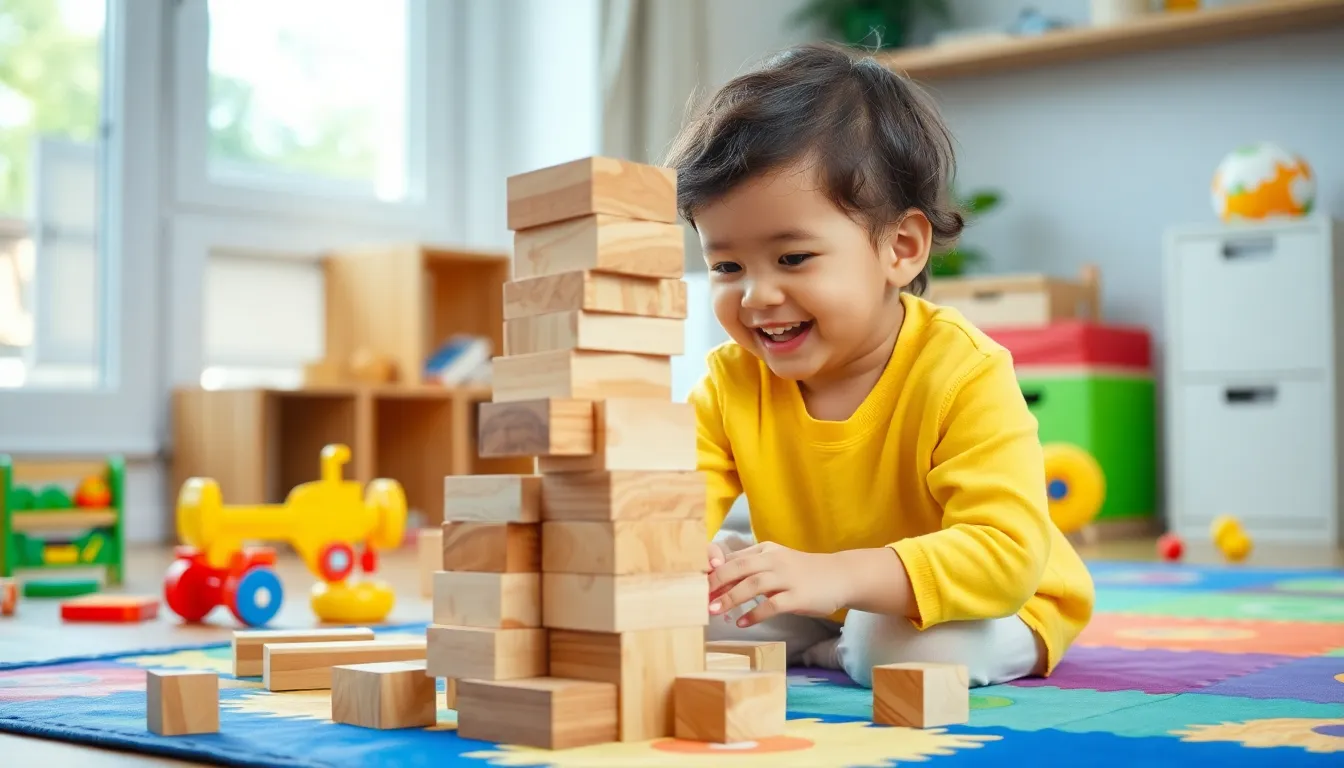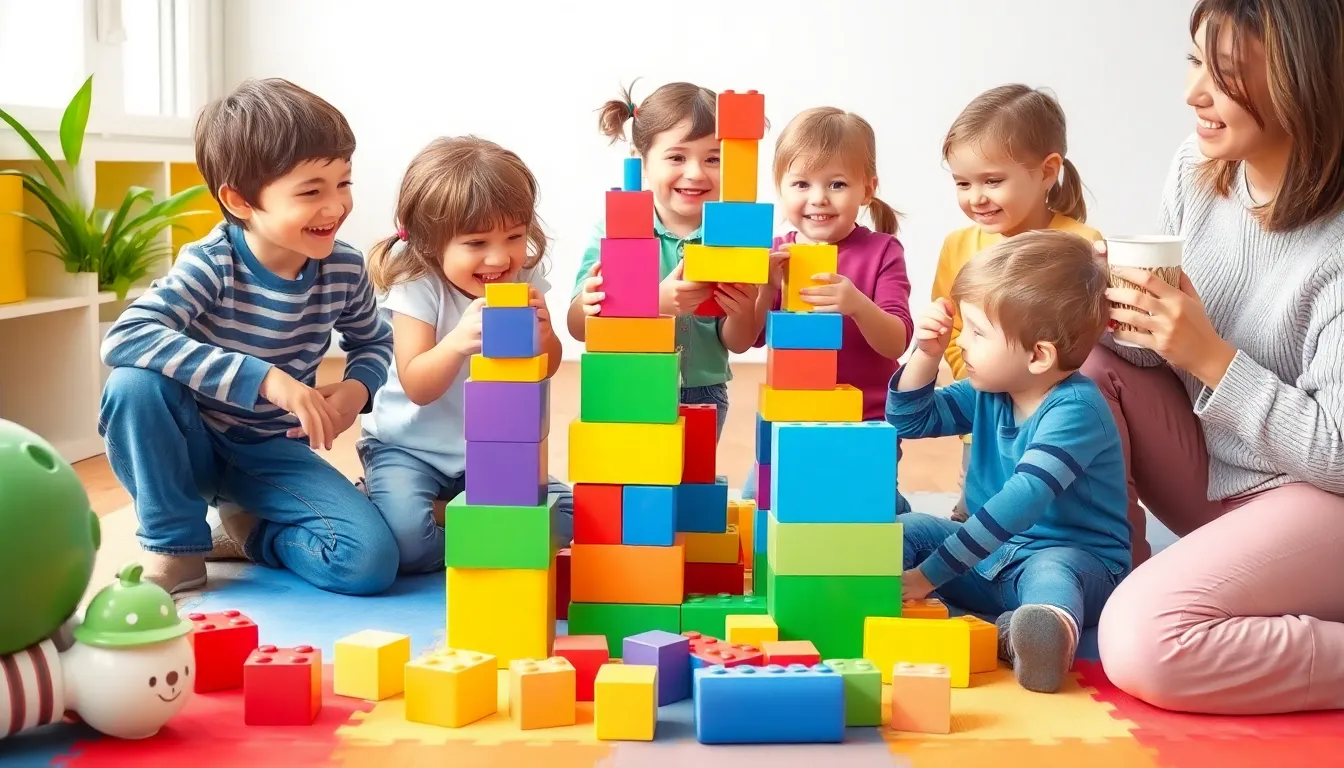Building activities for preschoolers aren’t just about stacking blocks and hoping for the best. They’re gateways to creativity, problem-solving, and a whole lot of giggles. Imagine a world where little hands construct towering masterpieces while parents sip their coffee in peace—sounds like a dream, right?
Table of Contents
ToggleImportance Of Building Activities For Preschoolers
Building activities play a crucial role in the development of preschoolers. They enhance motor skills through the manipulation of various materials. Engaging in these activities encourages creative expression, allowing children to explore their imagination. Problem-solving skills often emerge as kids figure out how to balance blocks or create stable structures.
Social interaction becomes vital during group building activities. Children learn to share materials and take turns, fostering teamwork. Cognitive development blossoms, with preschoolers learning about basic physics concepts like balance and gravity. Each experience contributes to a child’s understanding of space and structure.
Individual creativity thrives in an environment rich with building opportunities. The freedom to experiment with different designs supports critical thinking. Children gain confidence as they construct their ideas, leading to a sense of accomplishment.
These activities can be adapted to various themes, making them versatile. Parents can introduce tasks that align with a child’s interests, reinforcing engagement. Connection with peers enhances emotional development, allowing young learners to celebrate each other’s creations.
Parents observing their children during these tasks notice the joy and concentration displayed. Each completed project often sparks discussions on experiences and ideas, fostering language development. Overall, building activities serve as foundational experiences that shape preschoolers into innovative thinkers.
Types Of Building Activities

Building activities come in various forms, each offering unique benefits for preschoolers. Engaging in these activities stimulates creativity and cognitive growth, enriching the learning experience.
Block Play
Block play fosters spatial awareness and coordination. Children manipulate blocks of different shapes and sizes to create structures, enhancing fine motor skills in the process. This activity encourages problem-solving, as kids learn to balance blocks while experimenting with different configurations. Interaction during block play promotes teamwork, encouraging children to share their ideas and collaborate on projects. The satisfaction of building their designs boosts their confidence, making it a favorite among preschoolers.
Construction Sets
Construction sets provide an excellent opportunity for imaginative play. These sets typically include various interlocking pieces, sparking creativity in young minds. As kids connect different components, they explore engineering concepts while developing hand-eye coordination. Construction sets often come with instructions, introducing children to following guidelines. This aspect cultivates patience and perseverance as they work to complete their creations. Engaging in construction set activities promotes social interaction, fostering friendships through cooperative play.
Nature Building
Nature building invites creativity outside traditional materials. Using sticks, stones, and leaves, children construct unique structures that reflect their environment. This activity nurtures an appreciation for nature while developing problem-solving skills as kids figure out how to balance natural elements. Children learn about ecology and their surroundings, fostering curiosity and respect for the environment. Working together on nature-inspired projects encourages communication and collaboration, further enhancing their social skills. Nature building allows kids to express their creativity through the lens of the natural world.
Benefits Of Building Activities
Building activities provide numerous advantages for preschoolers. These experiences enhance development across cognitive and social domains.
Cognitive Development
Cognitive development improves significantly through building activities. Children explore basic physics concepts like balance and gravity by engaging with various materials. Structure and space become familiar as they construct different objects. Problem-solving skills emerge while figuring out how to create stable designs. Observing children during these activities reveals their critical thinking and experimentation. Each attempt encourages them to refine ideas, boosting their confidence. Engaging in such play allows preschoolers to apply their creativity, leading to a deep understanding of how things work. Encouraging these activities supports essential cognitive growth.
Social Skills Enhancement
Social skills enhancement occurs naturally during group building activities. Children learn the importance of sharing and taking turns while collaborating with peers. Interaction fosters teamwork as they negotiate roles and responsibilities. Observation shows that they celebrate each other’s creations, nurturing a sense of community. Engaging in these tasks helps them develop empathy and communication skills. Attending to their friends’ needs and ideas strengthens emotional bonds among preschoolers. This collaborative play creates a safe environment for expressing thoughts and feelings. Listening and responding to one another also enhances language abilities, contributing to overall social development.
Tips For Implementing Building Activities
Implementing building activities for preschoolers requires some thoughtful planning and consideration. Prioritizing safety and encouraging creativity can enhance these experiences.
Safety Considerations
Safety in building activities takes precedence. Choose age-appropriate materials to reduce injury risks. Soft blocks and large building sets minimize the chance of accidents. Always supervise children during activities, ensuring they don’t use small items that could pose choking hazards. Create boundaries in play areas to prevent falls and accidents. Incorporating safety guidelines helps children understand how to play responsibly. Reinforce the importance of being careful with structures they build, leading to a focus on both fun and safety.
Encouraging Creativity
Encouraging creativity is essential in building activities. Provide diverse building materials, from traditional blocks to recycled items, to spark imagination. Introduce open-ended challenges, allowing children to design their own structures without specific instructions. Asking questions about their creations fosters critical thinking, enabling them to reflect on possible improvements. Celebrate each child’s unique designs, reinforcing their individuality. Offering themes that align with their interests engages them further and inspires innovative thinking. Overall, nurturing creativity through building activities encourages exploration and self-expression.
Building activities for preschoolers offer invaluable benefits that extend far beyond playtime. These experiences nurture creativity and problem-solving skills while promoting social interaction and emotional growth. By engaging in various building tasks, children develop essential motor skills and gain confidence in their abilities.
Parents can create a rich environment filled with diverse materials that inspire exploration and innovation. Prioritizing safety and encouraging open-ended challenges ensures that every child can thrive in their creative journey. As children construct their ideas and collaborate with peers, they not only learn fundamental concepts but also build lasting memories. Embracing these activities paves the way for a bright future filled with imaginative thinkers ready to tackle new challenges.




